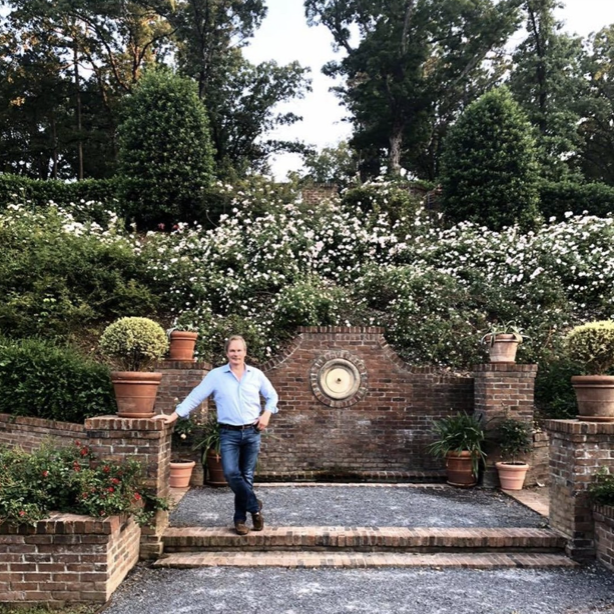Let the Land Speak
“While few of us inherit three-hundred-year-old gardens that have been lovingly passed on through generations, we can create our own garden homes that inspire us by following the same basic principles that guided the masters.”
P. Allen Smith is the Martha Stewart of Arkansas. He is, at the very least, a landscape designer, conservationist, and philanthropist, but in truth, to start this list is to limit his scope.
P. Allen, or just plain Allen Smith, is the product and prodigy of a long line of nurserymen. That speaks to me because horticulture is in my own DNA. Mr. Smith graduated from Hendrix College in Little Rock, Arkansas, and attended the University of Manchester in England on scholarship to study garden design and history. This unique opportunity shaped, or at least enhanced, Mr. Smith’s philosophy on landscape design and nature conservancy.
While attending the University of Manchester, he had the good fortune to tour and intimately study renown English country homes. These same homes were once toured and studied by Thomas Jefferson and John Adams for the same purpose and with the same result; namely, “approaching improvements of the land with a deep respect for a site’s inherent assets.” Mr. Smith’s philosophy is based in an intimate knowledge of classic English gardens and English estate landscapes, which are themselves are based in history and provide, as he contends, “significant precedent.”
He had me at English country homes. But he is interested in far more than good design. He is a steward of the earth. Allen Smith is a designer, conservationist, and visionary in one capable southern package.
(As an aside, he has also hosted three separate and successful television shows dedicated to all things garden, is a prolific writer and accomplished cook, built and maintains a working farm in Little Rock, which is open to guests, by the way, and is the founder of the Heritage Poultry Conservancy, dedicated to preserving heritage poultry breeds. He is a philanthropist by even the strictest definition and, to top it all off, he has partnered with architect Lew Oliver to develop several Traditional Neighborhood Developments. Whew! Yeah, he’s your classic overachiever.)
Mr. Smith is not unlike my modern British hero of architecture and design, Ben Pentreath. Pentreath and P. Allen Smith share a commitment to one thing that easily separates them from their contemporaries: Authenticity.
I am transported, as I browse Mr. Smith’s portfolio. I believe it. Is there any greater compliment to a designer, or indeed, any greater goal in design? Designers offer an experience. That’s why I love P. Allen Smith’s entire horticultural philosophy - let the land speak, and then respect what it says.
In a nutshell, that means the land does not require over-improvement. What Mr. Smith does masterfully is enhance what nature presents, directing the eye here, catching the breath there, revealing the view bit by bit, all with a loyal eye to what already is. He is a master of the most elusive design principle. Restraint.
I do realize that most of us are just trying to make the most of our postage stamp neighborhood plots. We aren’t recreating Downton Abbey over here. But, that’s the beauty of Mr. Smith’s philosophy. It’s a holistic approach. Things like setting and location matter. Natural resources matter. The architecture of the home, the neighborhood, the town, matter.
I lived near the Village of Wayne, Illinois a few years back. Wayne is an old, quaint equestrian town squeezed between St. Charles and West Chicago but belonging to neither. Being largely equestrian, it does not have the pseudo-European personality of St. Charles, or the utilitarian urbanism of West Chicago.
Wayne is a kind of turn-of-the-century time capsule, and I’m not talking the 21st century. Homes there are generally clapboard, many of them with acres of graceful, rolling hills wrapped in post-and-rail fencing. Downtown, charming and well-preserved little homes line the main street, snuggled in among the (only) church, the post office, and the railway station. The homes and the land speak to the activities that were and still are the heart of Wayne; horseback riding, fox hunting, and dressage.
In the 1980’s, someone decided to subdivide beautiful Wayne, Illinois. It could have gone terribly wrong. The developers clearly channeled their internal P. Allen Smith. They considered the bigger picture. Yes, they built subdivisions, a term they used loosely. They gave the new kids on the block the look and feel of historic Wayne. They incorporated generous lots with planned forestry, sweeping views, walking trails, and community lakes. They captured all the charm of old Wayne and reinterpreted it for modern living. I daresay Mr. P. Allen Smith would approve.
Details like these contribute to the success - the authenticity - of a project.
As a student of design, I appreciate Mr Smith’s take on landscaping. It’s not always perfect, and it’s certainly not one-size-fits-all. Every project has a unique set of circumstances, needs, and demands, and we do well to consider them when we design our own. Our homes and gardens will feel more authentic, and more personal if we do. And, finally, most importantly, I love the idea of letting the land speak, and then respecting what it says.
Blessing of the Hounds is an annual Wayne, Illinois tradition. Courtesy Village of Wayne
For more information on the talented and accomplished P. Allen Smith, please visit his personal website here, his design site here, his Heritage Poultry Conservancy site here, and enjoy the eye candy on his Instagram here. The Village of Wayne, Illinois is a well-kept secret, lovely in every season, and timeless in its sensibilities.













